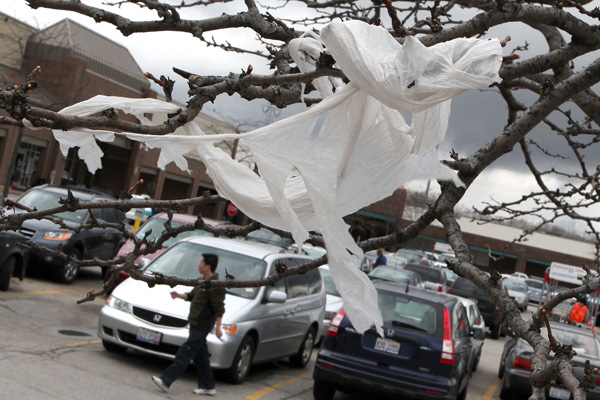
Photo: Antonio Perez/Chicago Tribune
The bag tree: An endangered species in Chicago?
Yesterday, Chicago's city council debated Joe Moreno's proposed ban on plastic bags at stores. Under Moreno's plan, stores would have to sell reusable ones and offer biodegradable options. (We actually don't really know what happens to plastic bags—they haven't been around long enough—but scientists believe they photodegrade over 500 to 1,000 years.)
It's an idea that's been floating around for a few years, and now it's got a tailwind. It comes not from the adorable children who showed up in support of the ban, but from our metropolitan peers in Los Angeles, who just banned the bags yesterday over the objections of the American Progressive Bag Alliance (no, really). Technically, they have to vote again, but it's popular in their city council and expected to pass:
Tuesday's 11-1 vote delivered a hard-fought victory to an array of environmental groups, which have been going city by city and county by county with campaigns to keep plastic bags out of landfills, waterways and the ocean. Although council members backed the concept of a ban last year, they voted Tuesday on specific legal language and how it would be enforced.
One likely reaction: We're all gonna die. Or more specifically: Some of us will die from increased E. coli deaths. If you follow this sort of thing, you may recall that an unpublished working paper caused a bit of a panic when it found that E. coli deaths in San Francisco spiked ("46 percent increase in the deaths from foodborne illnesses") after the city's 2007 ban.
But there are important caveats. First, it's a working paper. Second, it's correlation, not causation. Third, as Berkeley epidemiologist Tomás Aragón points out, the authors didn't sufficiently differentiate between types of intestinal infectious diseases:
The authors analyze deaths due to ICD-10 cause of death codes A00-A09 (intestinal infectious dseases). From 2001 through 2010 San Francisco had a total of 140 deaths from these causes. However, 111 of them (79%) were for code A047 (Enterocolitis due to Clostridium di fficile). These infections have indeed increased in San Francisco since 2005 (before the ban) (Table 1). Toxin-producing C. di fficile causes enterocolitis through overgrowth when exposed to antibiotics, most commonly in hospitalized patients. However, in recent years we have seen an unexplained increase of C. di fficile enterocolitis in the United States, Europe, and Canada. The increase in San Francisco probably reflects this international increase. Foodborne exposures is not yet an established cause of C. diffi cile enterocolitis, but is an active area of research.
For these reasons, the authors should not have included C. diff cile deaths in their analysis. Without C. diffi cile, there were a total of 29 deaths in these codes over 10 years through 2010. So their analysis of deaths, and costs due to deaths, is completely invalid as evidence for their argument about reusable bags.
Aragón has a number of other criticisms. But the paper isn't useless. Whether C. diff is foodborne isn't just an active area of research, it's something scientists are kind of freaked out about, but they're still working on it. There's some value to saying, "Hey, we should take a look at this," but it's not remotely causual yet. But don't take it from me, here's the lead author: "At the end of the day, we have a scientific basis that suggests this is a plausible idea."
So that's our own ecosystems. What about the greater environment? A lot of the push behind the plastic bag ban has been a quality-of-life issue; not everyone finds floating bags as poetic as emo movie kids. There is a plastic pollution problem in the Great Lakes, which comes up in the Trib article:
Stiv Wilson, spokesman for the 5 Gyres Institute that tracks plastic pollution in oceans and lakes, said his organization recorded the highest density of plastic byproducts in Lake Erie of any body of water it has tested around the world. "We expect that we will find similar results to Erie (in Lake Michigan)," Wilson said.
But much of that problem is tiny little plastics:
They’re finding tiny, perfectly round beads of plastic in many of the samples [from the Great Lakes], and this might hold another clue about the source of particles. “The cosmetics industry uses plastic micro-beads in soaps, toothpaste and other products. Because the products are not designed for ingestion, they don’t have to test for this. It’s completely unregulated and may be a significant source of micro-plastics finding their way into the environment,” she says.
Wilson's organization found 350,000 beads in one tube of facial cleanser. A plastic bag ban would reduce some of the visibly offensive plastic pollution, but there's a lot more that we can't see, and enough of a problem that cosmetic giant Unilever has gotten ahead of the game, phasing out microbeads by 2015.


